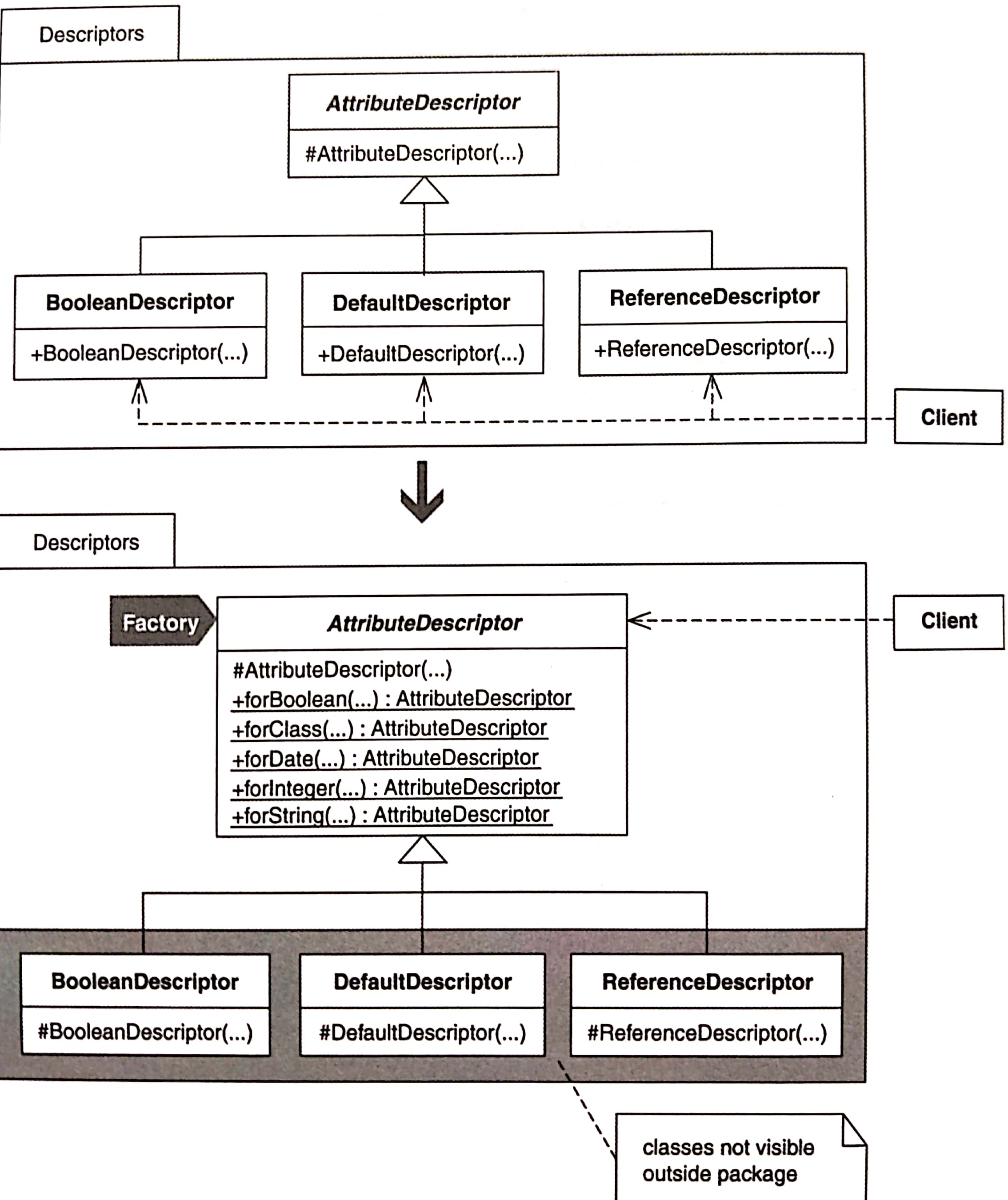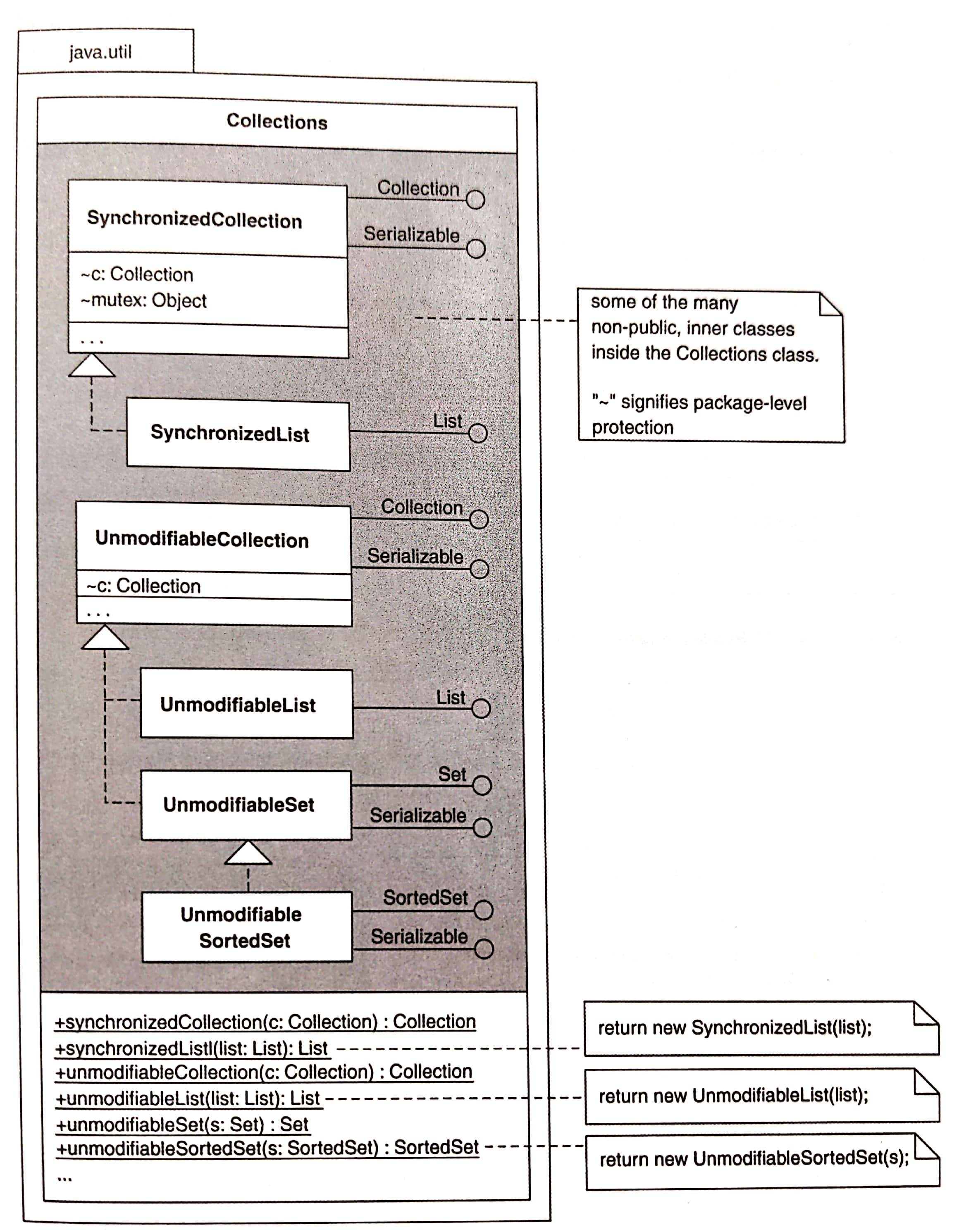# Encapsulate Classes with Factory
以 Factory 封裝眾多 Classes。

# 動機
只要客戶端需要知道「某個 classes 的實體存在」,客戶端直接具現那些 classes 的能力就有價值。但如果不需要那些知識,這些 classes 是位於某個 package 內並實作同一個 interface,而且這種情況不太可能改變,這種情況下 package 內的 classes 可以隱藏起來不被外界發現,作法是讓一個 Factory 創建並返回「實作某共同介面的實體」。
簡單來說:
- 「針對介面而非實體來編程」
- 藏起 package 內不需要曝光的 classes。
- 減少 package 概念的重量。
- 透過 Factory 意象清晰的 Creation Method 來創建實體,簡化各個實體的創建工作。
優點
- 透過「目的清晰」的函式產生各種實體,藉此簡化創建過程。
- 隱藏不須公開的 classes,並以此減輕 package 的概念重量(conceptual weight)。
- 有助於強制施行「針對介面編程而非實作編程」。
缺點
- 如果必須創建新種類的實體,就得創造出新的 Creation Methods 或更新舊的 Creation Methods。
- 當客戶端只能取用 Factory 的 binary code 而非 source code,客製化能力會受到限制
# 作法
當你的 classes 共用同一個 public interface,共用同一個 superclass,並且位於同一個 package 內時,一般來說你會想用這個重構手法。
- 找出「呼叫 class 建構式以創建某種實體」的客戶碼。
對「建構式呼叫動作」實施 Extract Method,建立一個 public static function,這個函式便是 Creation Method。
現在,實施 Move Method 把 Creation Method 搬到 callee 建構式所屬的 class 的 superclass 內。
- 編譯並測試。
- 找出上述的建構式的每個 caller,讓這些 caller 轉而呼叫 Creation Method。
- 編譯並測試。
- 針對這個 class 的建構式所創建的任何其他種類的實體,重複進行步驟 1 和步驟 2。
- 宣告 class 的建構式為 non-public。
- 編譯
- 針對你想封裝的所有 classes,重複步驟 1--4。
# 範例
以下範例是 ORM,用來讀寫某個關聯式資料庫。
這些 classes 協助把資料庫屬性映射到物件的 instance 變數。
package descriptors; public abstract class AttributeDescriptor... protected AttributeDescriptor(...) public class BooleanDescriptor extends AttributeDescriptor... public BooleanDescriptor(...) { super(...); } public class DefaultDescriptor extends AttributeDescriptor... public DefaultDescriptor(...) { super(...); } public class ReferenceDescriptor extends AttributeDescriptor... public ReferenceDescriptor(...) { super(...); }1
2
3
4
5
6
7
8
9
10
11
12
13
14
15abstract
AttributeDescriptor的建構式被設為 protected,他的三個 subclasses 的建構式則被設為 public。雖然我只列出三個 subclasses,實際大約有 10 個。先把重點放在
DefaultDescriptor。第一步驟是確定一種可被DefaultDescriptor創建的實體。為此我們檢視若干程式碼:protected List createAttributeDescriptors() { List result = new ArrayList(); result.add(new DefaultDescriptor("remoteId", getClass(), Integer.TYPE)); result.add(new DefaultDescriptor("createdDate", getClass(), Date.class)); result.add(new DefaultDescriptor("lastChangedDate", getClass(), Date.class)); result.add(new ReferenceDescriptor("createdBy", getClass(), User.class, RemoteUser.class)); result.add(new ReferenceDescriptor("lastChangedBy", getClass(), User.class, RemoteUser.class)); result.add(new DefaultDescriptor("optimisticLockVersion", getClass(), Integer.TYPE)); return result; }1
2
3
4
5
6
7
8
9
10我們發現
DefaultDescriptor被用來表現對Integer和Date兩種型別的 mapping。 雖然它也能用來映射其他型別,但我們一次只能專注一種情況。 於是創造一個 Creation Method 用來建立Integer型別的 "attribute descriptors"。一開始實施 Extract Method 產生一個
forInteger(...)的 public creation method:protected List createAttributeDescriptors() { List result = new ArrayList(); result.add(forInteger("remoteId", getClass(), Integer.TYPE)); ... } public static DefaultDescriptor forInteger(...) { return new DefaultDescriptor(...); }1
2
3
4
5
6
7
8由於
forInteger總是針對Integer創建AttributeDescriptors物件,所以不再需要傳給它Integer.TYPE:protected List createAttributeDescriptors() { List result = new ArrayList(); result.add(forInteger("remoteId", getClass())); } public static DefaultDescriptor forInteger(...) { return new DefaultDescriptor(..., Integer.TYPE); }1
2
3
4
5
6
7
8要將
forInteger回傳型別從DefaultDescriptor改成AttributeDescriptors,因為我們希望客戶端經由AttributeDescriptorinterface 和所有AttributeDescriptorsubclass 互動:public static AttributeDescriptor forInteger(...)...1現在,實施 Move Method 把
forInteger(...)搬到AttributeDescriptor:public abstract class AttributeDescriptor { public static AttributeDescriptor forInteger(...) { return new DefaultDescriptor(...); }1
2
3
4於是 client 看起來像是這樣:
protected List createAttributeDescriptors()... List result = new ArrayList(); result.add(AttributeDescriptor.forInteger(...)); ...1
2
3
4最後,編譯並測試。
尋找
DefaultDescriptor建構式的所有其他 caller,讓他們改成呼叫剛創好的那個 Creation Method:protected List createAttributeDescriptors() { List result = new ArrayList(); result.add(AttributeDescriptor.forInteger("remoteId", getClass())); ... result.add(AttributeDescriptor.forInteger("optimisticLockVersion", getClass())); return result; }1
2
3
4
5
6
7編譯並測試。
繼續為其他種實體創造出 Creation Method 時,重複步驟 1, 2。
public abstract class AttributeDescriptor { public static AttributeDescriptor forInteger(...) { return new DefaultDescriptor(...); } public static AttributeDescriptor forDate(...) { return new DefaultDescriptor(...); } public static AttributeDescriptor forString(...) { return new DefaultDescriptor(...); } }1
2
3
4
5
6
7
8
9
10
11
12
13將
DefaultDescriptor建構式宣告為 protected:public class DefaultDescriptor extends AttributeDescriptor { protected DefaultDescriptor(...) { super(...); }1
2
3
4編譯。
針對
AttributeDescriptor其他 subclasses 重複步驟 1--4。 完成後,新的程式碼:- 可存取
AttributeDescriptor的 subclasses... 經由他們的 superclass。 - 確保客戶端可以經由
AttributeDescriptorinterface 獲得 subclass 的實體。 - 防止客戶端直接具現
AttributeDescriptor的 subclass。 - 讓其他程式人知道
AttributeDescriptorsubclass 不對外開放。 客戶端與 subclasses 實體互動必須經由共同介面。
- 可存取
# 變異:封裝 Inner Classes
Java 的 java.util.Collections class 包含一個優秀範例:「以 Creation Method 封裝 classes 的所有細節」。這個 class 提供一個「讓 collections, lists, sets 和 maps 變成不可修改(unmodifiable)或同步(synchronized)」的方法給程式設計師。
作者使用具有保護作用的 Proxy [DP] 來實作。但他把 Collections class 裡的 proxies 定義為 non-public inner class,然後給 Collections 一組「程式設計師可以從中取得他們所需的各種 proxies」的 Creation Methods,而不是產生 public java.util Proxy classes(處理不可修改性和同步)然後再期待程式設計師來保護他們自己的 collections。
